Chords are the backbone of harmony in music, so knowing how to use them effectively can elevate your production game to new heights.
By understanding the different types of chords, you can create more interesting and engaging songs, and have a solid foundation for analyzing and composing music.
In this post, we’ll explore various types of chords, from major and minor to extended and augmented chords.
This comprehensive guide is perfect if you’re looking to expand your understanding of all the basic chords and how they work together.
So, grab your instrument (or DAW), and let’s get started!
Table of Contents
- Understanding Music Theory: Quick Recap
- 1. Major Chords and Major Scales
- 2. Minor Chords and Minor Triads
- 3. Diminished Chords and Half-Diminished Chords
- 4. Extended Chords
- 5. Seventh Chords
- 6. Augmented Chords
- Chord Progressions
- 7. Major Triads
- 8. Suspended Chords
- What Is A Chord Quality
- 9. Dominant Chords
- 10. Inversions
- Bonus: 10 Unconventional Ways to Use Chords
- Types of Chords: Final Thoughts
Understanding Music Theory: Quick Recap
Before diving into the types of chords and their purposes, it’s essential to quickly recap music theory.
Music theory is the foundation of understanding how different elements of music work together to create a cohesive piece.
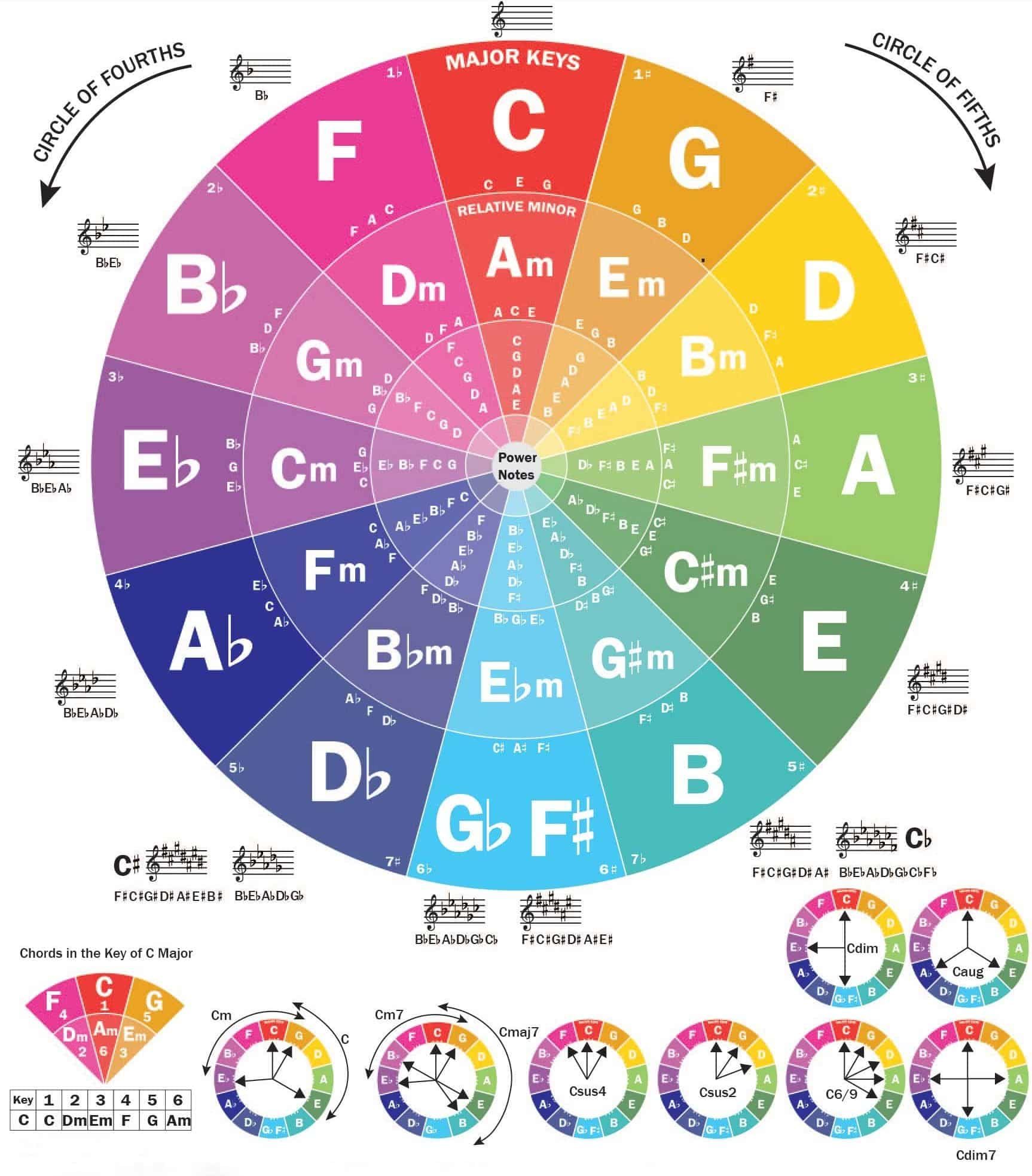
Knowing music theory allows you to create richer, more engaging compositions, and understand how chords and melodies interact.
It enables you to have a deeper understanding of the building blocks of music.
Which, in turn, will help you develop your unique sound and style.
Furthermore, having a solid grasp of music theory can make it easier to learn new instruments.
As well as experiment with different genres and analyze the work of other musicians.
This can be super beneficial when you’re looking for some extra inspiration.
1. Major Chords and Major Scales
Major chords are one of the most common types of chords in music, consisting of 3 notes.
Major chords sound happy, bright, and more uplifting than other chords.
They are incredibly versatile and are used in a wide range of music genres, from jazz to rock, pop, hip-hop, and EDM.
Their uplifting and consonant sound makes them suitable for various musical contexts.
You’ll need to get well acquainted with them in order to produce epic music.
A major chord consists of:
- The root note
- The Major third
- The perfect fifth
The major scale is a diatonic scale consisting of seven notes.

It follows the pattern:
- Whole Step (two semitones)
- Whole Step (two semitones)
- Half Step (one semitone)
- Whole Step (two semitones)
- Whole Step (two semitones
- Whole Step (two semitones)
- Half Step (one semitone)
The most common major scale is the C Major scale, which includes the notes C, D, E, F, G, A, and B.
How To Build Major Chords
To build a major chord, start with the root note, then add the major third, and finally the perfect fifth.
For example, to create a C Major chord, you’d combine the notes C, E, and G.
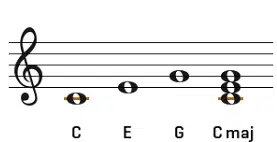
Other examples include F Major (F, A, C) and A Major (A, C#, E).
A major chord is built from the first, third, and fifth notes of a major scale.
This relationship to major scales means that the major chords naturally fit within the diatonic harmony of a given key.
Which allows for smooth and consonant chord progressions.
Understanding this connection between a major chord and major scales can help you make entrancing harmonies and a great chord progression.
2. Minor Chords and Minor Triads
Minor chords are made up of three notes and are another common chord type in music.
However, minor chords sound much darker and melancholic.
This characteristic makes the minor chord a popular choice in various music genres.
Especially when conveying deep emotions or setting a moody atmosphere.

A minor chord consists of these three notes:
- The root note
- Minor third
- Perfect fifth
Every major key has a Relative Minor key.
They share the same key signature and consist of the same notes but start on the sixth scale degree of the major scale.
This relationship between major and minor keys can be used to create interesting modulations and a smooth chord progression.
Understanding this connection can help you navigate harmonic choices and experiment with various tonal colors.
The Minor Scale
The natural minor scale is also a diatonic scale with seven notes.
It follows the pattern:
- Whole Step
- Half Step
- Whole Step
- Whole Step
- Half Step
- Whole Step
- Whole Step
Remember, a whole step equals two semitones, and a half-step equals one semitone.

An example of a natural minor scale is A Minor, which includes the notes A, B, C, D, E, F, and G.
Other examples include E Minor (E, F#, G, A, B, C, D) and D Minor (D, E, F, G, A, Bb, C).
How To Build Minor Chords
To create a C minor chord, start with the C major chord, which consists of the notes C, E, and G.
Then, lower the third note, which is E, by a half step to get Eb.

This creates a C minor chord, which consists of the notes C, Eb, and G.
To create the C minor chord, remember to start with the C major chord and then lower the third note by a half step.
3. Diminished Chords and Half-Diminished Chords
Diminished chords are known for their tense and unstable sound due to their unique structure.
These types of chords consist of two stacked minor thirds.
This dissonance can be used effectively to create a sense of unease or anticipation in a composition.
That is why they often serve as a transitional element between more stable chords.

A diminished chord is formed by combining:
- The root note
- Minor third
- Diminished fifth
One fascinating aspect of these chords is their symmetrical structure.
When you build a diminished seventh chord, every note in the chord is a minor third apart from the others.
If you transpose a diminished seventh chord up or down by a minor third, you essentially get the same chord with the same notes, just in a different order.
This feature can be used in various ways, such as creating smooth modulations between distant keys or adding a sense of ambiguity.
What Are Half-Diminished Chords? (HDCs)
Half-diminished chords, also known as minor seventh flat five chords, share some similarities with diminished (full) chords but have a slightly different structure.
An HDC is formed by combining:
- The root note
- Minor third
- Diminished fifth
- Minor seventh
An interesting fact about HDCs is that they can also be thought of as the seventh chord built on the seventh scale degree of a major scale.
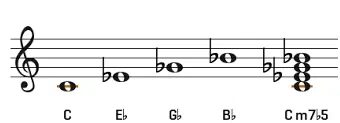
For example, in the key of C Major, the seventh scale degree is B, and the seventh chord built on B is a B half-diminished (B, D, F, A).
This relationship between HDCs and major scales can be useful when you’re looking to create chord progressions that fit within a particular key.
How To Build These Chords
- Diminished Chord 一 Start with the root note, add the minor third, and then the diminished fifth. To create a B Diminished chord, you’d combine the notes B, D, and F.
- Half-Diminished Chord 一 Add a minor seventh to the diminished chord. For a B Half-Diminished chord, you’d combine the notes B, D, F, and A.
An excellent example of a song that uses both diminished and HDCs is “Bad Guy” by Billie Eilish.
4. Extended Chords
A tetrad or extended chord are chords that contain notes beyond the basic triad structure.
They add extra color and depth and are commonly used to feature complex harmonies.
An extended chord is comprised of:
- The ninth chord
- Eleventh chord
- Thirteenth chord

With them, you can easily create a richer, more sophisticated harmonic texture in music.
They can add tension, release, and color to a chord progression, making it more engaging and dynamic.
How to build extended chords
Extended chords are built by adding notes beyond the seventh, using the diatonic scale as a reference.
- For example, to build a C Major 9 chord 一 start with a C Major 7 (C, E, G, B), and add the ninth (D).

- Similarly, to build a C Major 13 chord 一 start with a C Major 7 (C, E, G, B), and add the ninth (D), eleventh (F), and thirteenth (A).

If you’ve ever heard “Redbone” by Childish Gambino, then you’ve heard extended chords in all their glory.
5. Seventh Chords
Seventh chords are four-note chords that consist of a triad with an added seventh note above the root.
There are several types of seventh chords, including:
- Major seventh
- Minor seventh
- Dominant seventh
They are widely used in various music genres and provide a more complex sound than basic triads.
- To build a major seventh chord 一 Start with a major triad and add the major seventh (seven half steps above the root). For example, a C Major seventh chord consists of the notes C, E, G, and B. The C Major seventh chord is very popular.
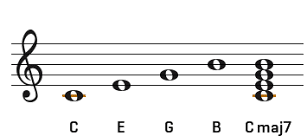
- To build a minor seventh chord 一 Start with a minor triad and add the minor seventh (six half steps above the root). A C Minor seventh chord consists of the notes C, Eb, G, and Bb. A C minor seventh chord is also very common.
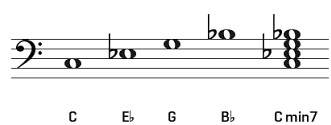
- To build a dominant seventh chord 一 Start with a major triad and add the minor seventh. A C Dominant seventh chord consists of the notes C, E, G, and Bb.
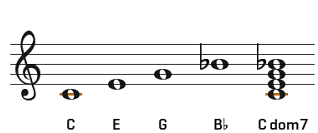
The Role Seventh Chords Play
Seventh chords are often used to add harmonic depth and complexity to chord progressions.
They can create a sense of tension and release, making the music more engaging and expressive.
Major seventh chords often have a sweet, smooth sound.
Dominant seventh chords, on the other hand, are commonly used to create tension before resolving to a more stable chord.
6. Augmented Chords
Augmented chords are a type of chord that features:
- A root note
- A major third
- An augmented fifth
They have a distinctive, dissonant sound and can create anticipation extremely well.
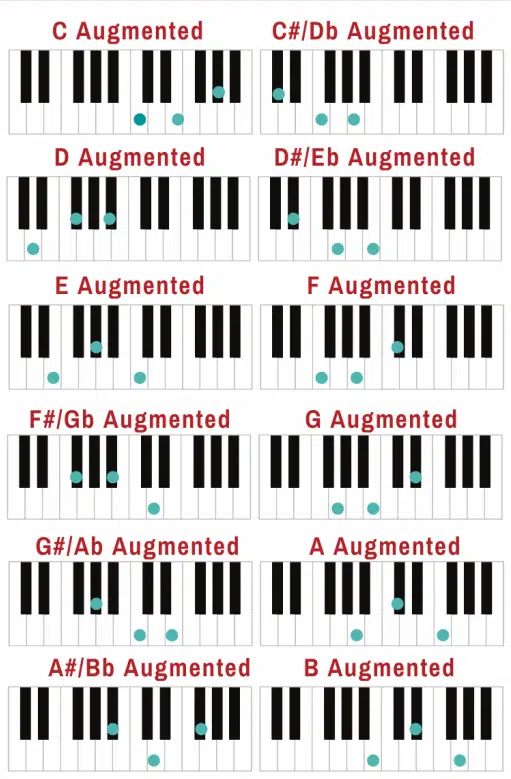
They are, however, much less common than major, minor, and diminished chords.
Mastering them can actually set you apart from other producers, as it evokes a very unsettling vibe, which could be super intriguing.
How To Build An Augmented Chord
To build one, start with the root note, add the major third, and then the augmented fifth.
For example, an augmented C chord features a C major chord, which consists of the notes C, E, and G.
In order to then make it an augmented chord, you would raise the fifth note, which is G, by a half step.

This results in the notes C, E, and G# 一 Successfully creating a C-augmented chord.
Augmented Chords In Music
Augmented chords are often used in music to create suspense or an unexpected twist in the harmony.
They can add a sense of surprise or dissonance that can make a progression more engaging and memorable.
An augmented chord is unique in that it doesn’t fit easily within a single key or tonality (like an altered chord).
They consist of two major thirds stacked on top of each other 一 creating an augmented fifth interval between the root and the fifth of the chord.
This dissonance can be used to create a sense of ambiguity or tension.
Chord Progressions
Chord progressions are sequences of chords that form the harmonic foundation of a piece of music.
They provide a structure for the melody and rhythm and help to create a sense of movement and development in the music.
One interesting fact about chord progressions is that many of them can be traced back to common harmonic patterns that have been used in music for centuries.
However, despite their widespread use, progressions can still be arranged in new and creative ways, so remember to experiment and explore.
Common Chord Progressions
Some common progressions include:
- The I-IV-V progression 一 One of the most commonly used progressions in music. This progression is built around the tonic, subdominant, and dominant chords of a major key.
- The II-V-I progression 一 Involves moving between the second, fifth, and first chords of a major or minor key. Often used as a cadential progression to create a sense of resolution.
- The I-V-vi-IV progression 一 Also known as the “pop-punk” progression. It consists of the tonic, dominant, relative minor, and subdominant chords of a major key.
These progressions provide a reliable and familiar structure that can be adapted and modified to create a wide range of musical styles.
How To Create Your Own Progressions
When creating your own progressions, consider the key of your piece and the chords that naturally occur within that key.
Experiment with different combinations of chords, focusing on the movement between them and how they create tension and resolution.
Don’t be afraid to try unconventional progressions or mix in less common chord types to add variety and interest!
7. Major Triads
Major triads are the most basic form of major chords, consisting of just the root note, a major third, and a perfect fifth.
They form the basis for more complex chords and are a fundamental building block in music theory.
Major triads are often associated with a sense of stability, resolution, and completeness in music.
- To create a C Major triad 一 Combine these three notes: C, E, and G.
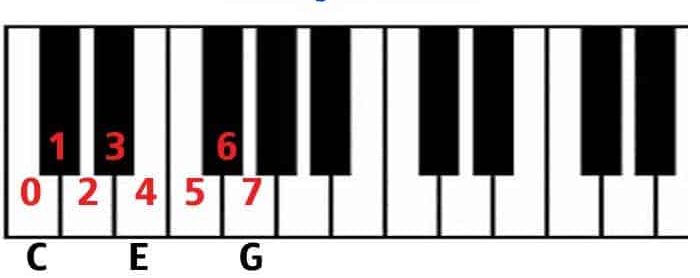
Its notes create a harmonically stable and consonant sound.
Major triads are commonly used as tonic chords in a piece of music, providing a sense of grounding and closure to a phrase or section.
To build a major triad, start with the root note, add the major third (two whole steps above the root), and then the perfect fifth (three and a half steps above the root).
Major Triads In Music
Major triads, like a C major triad, are the foundation of many chord progressions and are used in virtually all genres of music.
Triad chords provide a simple, consonant harmonic structure that can be easily combined with other chords to create more complex progressions.
8. Suspended Chords
A suspended chord is a chord in which the third is replaced with either:
- The perfect fourth
- The major second
This unique substitution creates a painfully beautiful sense of suspense.
There are two main suspended chord types:
- Suspended 2nd (sus2) 一 Consists of the root, second, and fifth notes of a scale.
- Suspended 4th (sus4) 一 Replaces the third note of a Major or minor triad with the fourth note.
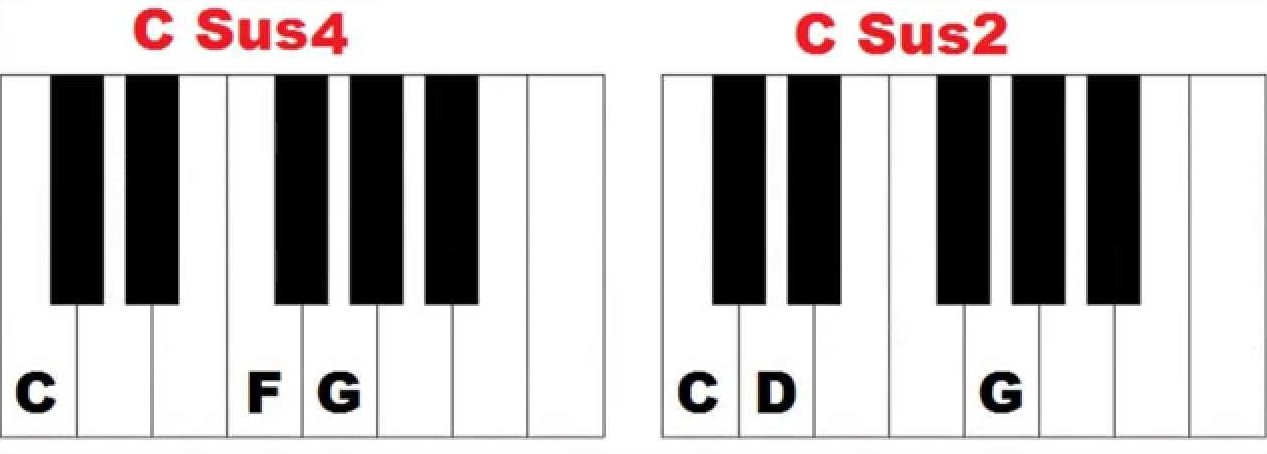
The suspended 2nd chord has a unique and open sound that creates a sense of tension and anticipation.
This makes it perfect for captivating your listener before ultimately resolving to a more stable chord.
The suspended 4th chord on the other hand is ideal for adding interest to a chord progression, or when you’d like to introduce a new tonal color.
Interestingly, these chords can also be used in combination with each other, creating a suspended hybrid chord that includes both the second and fourth notes.
Suspended Chords: Breaking It Down
To build a sus2 chord:
- Start with the root note
- Add the major second
- Add the perfect fifth
For example, to create a C Sus2 chord, you’d combine the notes C, D, and G.
To build a sus4 chord:
- Start with the root note
- Add the perfect fourth
- Then add the perfect fifth
For example, to create a C Sus4 chord, you’d combine the notes C, F, and G.
What Is A Chord Quality
The term ‘chord quality’ refers to the characteristics of a chord that define its sound and function in a piece of music.
The main qualities are:
- Major 一 Have a major third and perfect fifth
- Minor 一 Have a minor third and perfect fifth
- Diminished 一 Have a minor third and diminished fifth
- Augmented 一 Have a major third and augmented fifth
- Suspended 一 Have either a major second or perfect fourth and a perfect fifth
Each of which, as you now know, has a unique texture and role in creating harmony.
By using a variety of chord qualities, you can create different moods and emotions in your music.
As well as add tension, release, and color to your harmonies, naturally.
To identify the quality of a chord, examine the intervals between its notes.
The song “Viva La Vida” by Coldplay contains a variety of different chord qualities, which all beautifully blend together.
9. Dominant Chords
Dominant chords, also known as dominant seventh chords, are a type of seventh chord that consists of a major triad with an added minor seventh.
They have a strong, tense sound and are often used to create a sense of resolution in a chord progression.
How To Build Dominants
To build a dominant chord, start with a major triad, and add the minor seventh (six half steps above the root).
- To create a G Dominant 7 chord 一 you’d combine the notes G, B, D, and F.

These chord types are often used to set up a resolution to the tonic (I) chord, creating a sense of completion and stability in the harmony.
This is particularly common in the V-I progression, where the dominant chord is built on the fifth degree of the scale and resolves to the tonic chord.
A great example of a song that uses dominants is “Creep” by Radiohead.
The song features a G Dominant 7 chord in the chord progression, which elicits anticipation before resolving to the C Major chord.
10. Inversions
Inversions are chords in which the notes are rearranged so that a note other than the root is the lowest note of the chord.
There are three types of inversions for triads:
- Root position (root in the bass)
- First inversion (third in the bass)
- Second inversion (fifth in the bass)
To build an inversion, start with a basic chord, such as a major, minor, or diminished triad.
Then, simply rearrange the notes so that a different note is the lowest note.
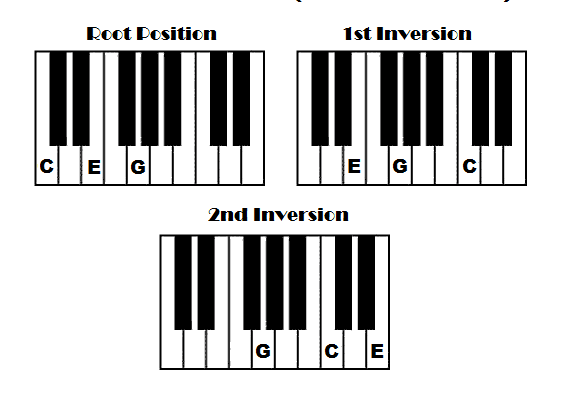
For example, to create a C Major chord in the first inversion (E in the bass), you’d rearrange the notes to be: E, G, and C.
It changes the color and character of the chord.
This, in turn, makes it sound more open, bright, or dark, depending on which note is played in the bass.
Inversions can also be used to create smooth and flowing chord progressions.
The notes of one chord can be used as a common tone or a pivot note to transition to the next chord.
Bonus: 10 Unconventional Ways to Use Chords
- Use a pedal point 一 Hold a single bass note while changing the chords above it, creating a sense of tension and release.
- Use polychords 一 Layer two different chords on top of each other to create a complex and unique sound.
- Use chromatic chord progressions 一 Move chords up or down by half steps, creating a sense of tension and unpredictability.
- Mix modes 一 Combine chords from different modes, such as mixing chords from the major and minor scales, to create an interesting and unique harmonic landscape.
- Employ quartal harmony 一 Build chords using fourth intervals instead of thirds, creating a more open and spacious sound.
- Utilize secondary dominants 一 Use a dominant chord from a key other than the one you’re in to create a temporary sense of tension and resolution.
- Use deceptive cadences 一 Resolve a dominant chord to a chord other than the expected tonic, creating a surprising twist in the harmony.
- Experiment with tritone substitutions 一 Replace a dominant chord with another dominant chord a tritone away, creating an unexpected shift in the harmony and adding tension.
- Incorporate modal interchange 一 Borrow chords from parallel modes, such as using chords from the parallel minor in a major key, to add color and contrast to your chord progressions.
- Use clusters 一 Create chords by stacking adjacent notes in close proximity, resulting in a dense, dissonant sound that can add tension and complexity to your music.
Types of Chords: Final Thoughts
Understanding the various types of chords and their roles in music is crucial for any music producer looking to create engaging, expressive compositions.
By exploring all the unique chord variations, you can create a rich, harmonic landscape that will captivate your listeners.
Don’t forget to incorporate those unconventional methods as well, as they can set you apart from the competition!
As you continue to experiment and practice with these chords and techniques, you’ll develop a greater understanding of how to use them effectively.
Therefore, you’ll elevate your music production skills to new heights.
Another way to stand out from the competition in a major way is to use already mind-blowing, pristine, professionally crafted chord progressions.
Luckily, we have the most unique and intriguing ones on the planet… and they’re free!
Download the FREE Unison Essential Advanced MIDI Chord Progressions to have access to the sickest progressions available today.
Needless to say, you’ll have an almost unfair advantage over your competition.
Until next time…







Leave a Reply
You must belogged in to post a comment.